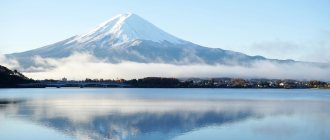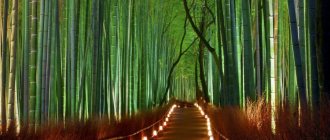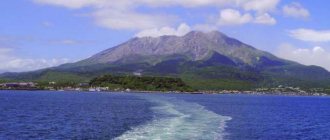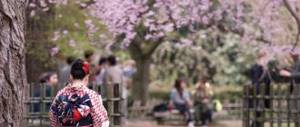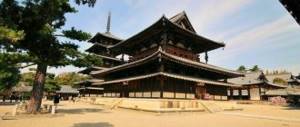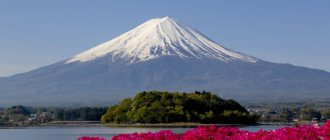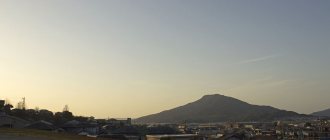Japan or the land of the “rising sun” is a fairly large island state in East Asia. And it is called that because it is geographically located to the east of all countries and is the first to greet the rising sun. In addition, the official name of this country is “Nippon Koku” or “Nihon Koku”, which literally translates as “homeland of the Sun”. That is why the flag of Japan since 1870 has looked like a white cloth with an image of a red ball in the center, representing the rising sun. This fact makes Japan not only a country amazing in its beauty, but also unique in its natural content.
General information about the nature of Japan
The nature of Japan, “the land of the rising sun,” is extremely interesting.
Unique animals and bacteria, fungi and plants live here. The number of endemic species (species of living beings living in a certain area of not very large size limited by biotic, climatic or geological factors, in other words, species of animals or plants living only in one specific small space) of the archipelago reaches as much as 40%!
This is due to the fact that at the very beginning of the formation of the modern appearance of our planet, Japan broke away from the main continent, and evolution here took a special path, different from the continental one - development took place in isolation in a relatively small area. By the way, for a similar reason, koalas and kangaroos live only in Australia, and you can see a lemur in its natural habitat only in Madagascar. Currently, Japan has 6,852 islands in its possession, of which the 4 largest in area are: Hokkaido, Kyushu, Honshu and Shikoku. They together make up a little more than 97% of the area of the entire country, and the remaining 6848 islands are only about 2-3%. At the same time, the main (largest) is Honshu, whose area is 227,969.74 km² or approximately 61% of the entire territory, then Hokkaido 83,400 km² or 23%, Kyushu 40,600 km² or 10% and Shikoku 18,800 km² or 4%. Many songs have been written about the beauty of nature. The lyrics often glorify and make us rejoice in the beauty of our native nature.
Climatic features of Japan
Due to the fact that the Japanese islands stretch vertically across the globe, that is, parallel to the meridian, the country has several climatic zones, which is rare in countries of its rather modest area. The northern part of the archipelago is covered by a cold climate zone, the “middle” - most of it - is temperate, and the southern islands of the archipelago are subtropical. Thus, Japan is located in three climatic zones at once with its relatively small size - only about 377,900 km², comparable to 1/45 of the area of Russia. The Pacific Ocean washing the shores of the “land of the rising sun” brings warm winds to it, so the temperature here is always several degrees higher than in the same climate zone at the same time on the mainland. In Japan, in summer, in addition to warm temperatures, there is very high humidity and numerous precipitation, which is explained by the fact that liquid evaporates from the nearby seas (mainly the Sea of Japan) and humid winds are carried to the islands. Unfortunately, the largest ocean on the planet brings residents of the archipelago not only pleasant breezes, but also typhoons in the summer. Such natural disasters annually cause considerable destruction, and sometimes even human casualties cannot be avoided.
Ecological situation
Problems
Today Japan is taking all necessary measures to preserve the environment, damage to which was caused by the “industrial boom”. The air and water were damaged.
In addition to these problems, there is another one that disturbs the population - high noise levels. But the state is taking all possible measures for this.
2011 was a year of great shock for the country’s ecology—due to the accident at the Fukushima I nuclear power plant, a severe radiation leak occurred.
Relief and seismic movements
The relief of Japan has a rather complex structure. There are many mountains and volcanoes on the territory of this country. Its main mountain ranges are the Japanese Alps, Kiso, Ou, Akaishi and Daisetsuzan, and the highest point of the Japanese archipelago is Mount Fuji, known to everyone at least by name. In general, volcanoes are not uncommon on these islands: there are just over two hundred of them! Of these, 67 are considered to be “living,” that is, not yet extinct (dormant or active). Japan is home to 10% of the world's active volcanoes. Earthquakes in the Japanese archipelago are also not uncommon: about three small ones occur here every day. A huge number of mountain ranges, uneven terrain and volcanoes, the frequency and destructiveness of earthquakes are predetermined by the unfavorable geographical position of Japan relative to the lithospheric plates - huge stable parts of the earth's surface (the earth's crust). The fact is that the islands are located at the junction of as many as four lithospheric plates (one small and three large): Philippine, Eurasian, Pacific and North American. Their slow movements over many years form those same numerous mountain ranges, “layering” one on top of another and provoke earthquakes and volcanic eruptions, colliding with each other.
What is the country known for?
There is something for everyone in Japan. It is the only Asian country in the G7 and a great economic power. Travelers are interested in Japan and its nature, cuisine, traditions, and culture. The Japanese language itself, the Japanese, and their way of life arouse genuine interest.
Japan's water resources
Japan is a country located on islands that belong only to it, so it does not have a land border, that is, it does not border on land with any state. The empire is washed by 3 seas: the Sea of Okhotsk on the north side, the Sea of Japan (otherwise known as the East Sea) and the East China Sea on the west. On the southern and eastern sides, Japan is washed by the Pacific Ocean, considered the largest and deepest on the planet. The largest and most famous lake in the Japanese archipelago is Biwa, located almost exactly in the center of Honshu. Its area is 670 km². The lake itself contains 4 islands: Chikubushima, Okishima, Takeshima and Okinoshiroishi. More than 200 mountain rivers flow into the lake, of which there are many in Japan due to the large number of mountain ranges. But not many Japanese rivers are truly great. The Sinano River reached its maximum length of 367 km. For comparison, the length of the Indus River is 3180 km, which is almost 9 times the length of the Sinano River. The rivers of Japan simply physically cannot be longer - they are limited by the small area of the islands. It is not surprising that the longest river in Japan is located on the island of Honshu, because, as mentioned earlier, it is the largest island of the archipelago.
Animal world
The country's fauna amazes any tourist who has visited Japan at least once. The state is located in an isolated area and has a wide variety of climates. That is why many endemic animals (living only in a certain area) live there.
One of the most striking representatives of birds is the “kiji” - the green pheasant. The bird is a symbol of the country.
The sika deer is an animal that is highly respected by the people of the country.
Japanese serow - inhabits only the island of Honshu.
The Japanese macaque is found only on the islands of Japan.
The white-breasted or Himalayan bear is a unique, proud and beautiful animal.
The Japanese dormouse is endemic.
The Japanese crane has long been an integral tribute to Japanese culture, representing longevity and prosperity.
The Japanese giant salamander lives in the country's water bodies.
Flora of Japan
Japan is also famous for its forests. They occupy about 66.6% of the entire territory of the archipelago. The main types of forest common in the “land of the rising sun” are broad-leaved, tropical and subtropical. Another one is a bamboo forest. Bamboo is durable, flexible, convenient for making household items such as furniture or wicker baskets, and it also grows extremely quickly - up to 20 meters in height and 20 centimeters in width in just one month, which makes it possible to grow and use it in almost unlimited quantities. Such seemingly harmless bamboo forests, which have doubled in size over the past couple of decades, threaten the disappearance of such valuable tree species as castanopsis, oak, star anise, camellia and simplocos from the islands. In total, in Japan, scientists count about 600 species of trees and shrubs, 180 species of cereals and 2,200 species of other herbaceous plants. Of course, one of the main symbols of Japan, along with geishas, samurai and the red rising sun, is the blooming pink sakura, which is often also called the Japanese cherry. Cherry blossom time is the most beautiful and magical period of the year. The fruits of this picturesque tree are never eaten in their pure form; they are mainly used in winemaking, that is, for the production of wine and various cherry liqueurs. The Japanese like to decorate dishes with fresh sakura flowers much more. In total, in Japan there are 16 species of this unique tree and at least 400 of its varieties, bred by Japanese scientists who, like everyone else in Japan, are simply crazy about this unique tree.
Beautiful cities
Of course, the most visited city is the capital of the Land of the Rising Sun - Tokyo, where both traditional Japanese culture and modern life are combined. There are a lot of must-see attractions here: the Imperial Palace, Sandoji Temple, Yegi Park.
Kyoto is a city rich in a huge number of ancient buildings, such as the Imperial Palace. Some streets are even listed as UNESCO World Heritage Sites.
Osaka is a busy city, but despite this, its area is quiet enough to take a break from the noise of the city. The Dontonbori and Shinsaibashi areas will be no less interesting to tourists.
Nagano is famous for its beautiful scenery and is also famous for its soba noodles, which anyone can learn to cook in master classes.
In order to understand the country and touch its history, you must definitely visit Hiroshima. Many have heard about the tragic fate of two Japanese cities - Hiroshima and Nagasaki, on which bombs were dropped and innocent people died. The Peace Memorial Museum is a must-see for those who are ready to feel all this pain.
Fauna of Japan
General information about animals
The fauna of the Japanese archipelago is very unusual; it cannot be called poor or undiversified, although it is slightly inferior to the nature of Asia. It is home to 270 species of mammals, just over 800 species of birds, approximately 110 species of reptiles, more than 600 species of fish and over a thousand species of marine mollusks. Interestingly, often the same species of animal in Japan is smaller in size than its counterpart living on the mainland. For convenience, the separate unofficial term “Japanese subspecies” was introduced to designate the species of animals that encountered this phenomenon. One of the favorite animals of the Japanese is the sika deer - an animal of the Deer family, usually reaching a length of one and a half meters to 180 centimeters. These deer are listed in the International Red Book of Wild Animals. Such unique Japanese animals as the flying squirrel, the long-tailed tit, the Hokkaido red fox, the Hokkaido red squirrel, the “crying rabbit” - the interesting thing is that this particular animal became the prototype of the popular cartoon character Pikachu, Iizuna - a type of small predatory mammal weasel - and many Other animals that live only in Japan are always popular with tourists.
Animal protection
In order to protect the animals, the Japanese built countless national parks and reserves throughout the archipelago. At the moment, there are already 33 national parks with a total area of 20,482 km², which is about 5.6% of the total area of the country. This is larger than Shikoku, one of the four largest Japanese islands. The five most popular national parks are Akan (founded 1934), Ashizuri-Uwakai (1972), Aso-Kuju (1934), Bandai-Asahi (1950) and Daisetsuzan (1934). There are also more than 2,000 game reserves and over 300 nature reserves.
Interesting Facts
The history and culture of Japan are so interesting and go back to ancient times that it would probably be impossible to highlight just a few interesting facts.
But here are the most interesting of them:
- Japan does not have a standing army, according to the Constitution. The country has a so-called “Self-Defense Army”, which was created to protect its borders from enemy attacks.
- The Japanese Empire came to an end on May 3, 1947. It has existed since January 3, 1868, and has been ruled by only three emperors.
- This is a real land of long-livers: the average life expectancy of the Japanese is 83.3 years.
- There is no central heating in the country.
- Japan is the only country that has had nuclear weapons used in military operations.
- A young Japanese woman can wear a fairly short skirt, and this is considered absolutely normal. You can find out what the module is by following the link.
Ecology and natural problems of Japan
From the above, you can easily understand that the Japanese treat the nature around them with great care and love, but this was not always the case. In the 60s-70s of the last century, the ecology of the capital of Japan - Tokyo - was terrible, the air was so polluted that it was difficult to breathe, and a lot of waste was not properly disposed of, but was simply thrown into water bodies. In 1969, a turning point occurred. The Japanese government has issued a law to control environmental pollution in the capital. Over 6 long years, the Japanese managed to change the past deplorable situation and reduce the concentration of pollution and exhaust in the air by 2 times. But this was not enough - the air was now extremely polluted in the suburbs. Having discovered the cause - car exhaust gases - and having found a suitable solution - to try to reduce the amount and harmfulness of emissions - Japanese scientists began to work. They managed to invent special devices that significantly reduce the amount of harmful gases, and now the Japanese ecology can even be kindly envied.
Minerals
Japan's natural mineral resources are represented in relatively small quantities. Mostly, they are not enough for the independent development of industry, so the state has to partially cover the shortfall by importing raw materials, such as oil, natural gas, and iron ore.
The country has deposits of sulfur, small reserves of manganese, lead-zinc, copper, silver ore, gold, chromite, iron ore, and barite. Its oil and gas reserves are small. There are small deposits of vanadium, titanium, polymetallic, nickel, lithium, uranium and other ores. In the world, Japan is one of the leaders in iodine production.
Limestones, sands, dolomites and pyrites are contained in significant quantities. The state is rich in iron sands, which have long been used in the manufacture of the famous Japanese steel for blades, knives and swords.
